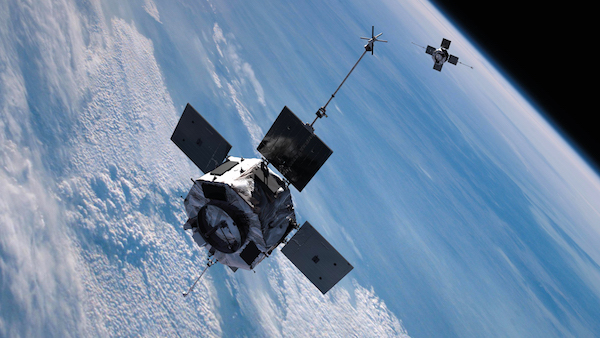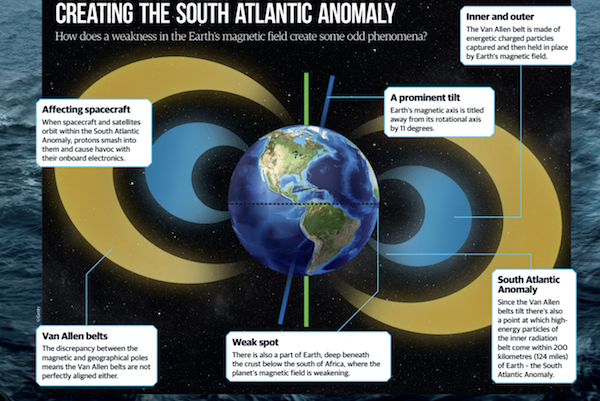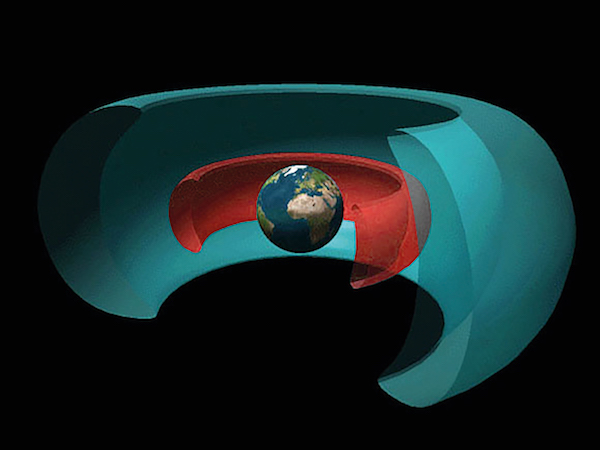South Atlantic Anomaly: Have astronomers finally explained space's Bermuda Triangle?
Space Mysteries: Spacecraft go haywire and sometimes meet their doom in an area above Earth that's blasted by high doses of radiation

There is an area of the North Atlantic Ocean known as the Bermuda Triangle where ships, airplanes and people have been known to disappear without explanation. No-one knows for certain why more than 50 ships and 20 planes have vanished since the mid-19th century. But that's not to say people haven't had some fun seeking an explanation.
Maybe it's to do with extraterrestrials, a force pulling objects under the sea or a link to the fabled lost city of Atlantis? Or perhaps it's simply bad weather, human error or heavy traffic in the region? In truth, the number of disappearances are actually no more than in any other well-traveled area of the ocean, yet, still, the conspiracy theories persist.
If we look skyward we can explore a similar phenomenon dubbed the "Bermuda Triangle of space" – a vast region above Earth has been known to wreak havoc on spacecraft that happen to enter the area. In this case, nobody is claiming that craft are suddenly vanishing into thin air, but the disruption that's being caused is nevertheless serious, and it poses great problems for both equipment and astronauts.
Where is the South Atlantic Anomaly?

The South Atlantic Anomaly lies above the South Atlantic, stretching from Chile to Zimbabwe.
Higher amounts of radiation affects the spacecraft's onboard electronic systems.
The "dent" in the magnetic field is actually moving westward and splitting in two.
The Bermuda Triangle of space – or the South Atlantic Anomaly (SAA) as it is formally known – lies above the South Atlantic, stretching from Chile to Zimbabwe. It sits at the point where the inner Van Allen radiation belt comes closest to Earth's surface. Here, Earth's magnetic field is particularly weak.
To explain, Earth has two Van Allen belts – a couple of doughnut-shaped rings of charged particles that surround our planet, held in place by Earth's magnetic field. The inner part consists mainly of high-energy protons and the outer part is mainly electrons. Because the belts trap the particles that are shooting from the surface of the sun, they end up protecting the surface of the planet from harmful radiation.
At the location of the SAA, however, the particles of solar cosmic rays are not being held back to the same extent as they are elsewhere above the planet. As a result, solar rays come as close as 124 miles (200 kilometers (124 miles) to the Earth's surface and the more intense solar radiation results in an increased flux of energetic particles in this area.
"I'm not fond of the [Bermuda Triangle of Space] nickname, but in that region, the lower geomagnetic field intensity eventually results in a greater vulnerability of satellites to energetic particles, to the point that spacecraft damage could occur as they traverse the area," said John Tarduno, professor of geophysics at the University of Rochester.
This causes problems with communications satellites and other equipment because the lower magnetic field intensity allows Earth's radiation belt — technically the inner Van Allen radiation belt — to come closer to Earth's surface.
"Satellites passing through this region will experience higher amounts of radiation to the point that damage could occur," Tarduno told All About Space. “Think about an electrical discharge or arc. With more incoming radiation, a satellite can become charged, and attendant arcs can result in serious damage."

This article is brought to you by All About Space.
All About Space magazine takes you on an awe-inspiring journey through our solar system and beyond, from the amazing technology and spacecraft that enables humanity to venture into orbit, to the complexities of space science.
What happens to spacecraft and astronauts in the South Atlantic Anomaly?
Ordinarily the Van Allen belts stretch at an altitude of between 1,000 and 60,000 km (620 and 37,000 miles(1,000 and 60,000 km) above Earth's surface. The low altitude of the radiation hotspot, however, puts it within the orbit of certain satellites, which become bombarded by protons that exceed energies of 10 million electron volts (eV) at a rate of 3,000 "hits" per square centimetersr per second.
As Tarduno pointed out, this affects the spacecraft's onboard electronic systems, which hampers the operation of these objects. To protect them from potential hardware damage, space agencies and other satellite operators power them down so that the anomaly doesn't end up knocking out onboard computers and interfere with data collection.
Shutdowns protect many important studies, including those using the Hubble Space T telescope, which passes through the SAA 10 times a day, spending a good 15% of its time there. Hubble is unable to collect astronomical data during these moments, which is not ideal, but necessary. Failing to take precautions would likely lead to system failure.
Certainly, the more complex electronics have become, the more potential there is for problems to emerge. Satellites using the microwave tracking system DORIS — which stands for Doppler Orbitography and Radiopositioning Integrated by Satellite — for example, see a resulting shift of the onboard oscillator frequency.
Related: 'Vigorous' magnetic field oddity spotted over South Atlantic
Astronauts have also witnessed problems with computers on board spacecraft that fly in the vicinity of the SAA. "Putting equipment into a 'safe mode' means operations that are more vulnerable to radiation are curtailed," Tarduno said.
Indeed, the SAA is why strong shielding is in place over the most frequently occupied parts of the International Space Station (ISS), such as the gallery and the sleeping quarters, reducing the amount of radiation the astronauts are exposed to. It's also why astronauts wear dosimeters (devices that measure their personal exposure to ionising radiation in real time) that send out a warning if they reach dangerous levels.
What causes the South Atlantic Anomaly?
But why is the magnetic field weaker above the South Atlantic? It's because of the shape of Earth, which is not completely round. The Earth bulges slightly in the middle, and the planet's magnetic dipole field is offset from its center by about 300 miles (500 km (300 miles). Where the dip lies, the charged particles and cosmic rays are closer to Earth's surface and provide less insulation from interplanetary space. Even so, this magnetic bubble still prevents solar wind from reaching the surface.
The magnetic field is sustained by a dynamo process that results from the flowing liquid metal in Earth's outer core that generates electric currents. When the planet rotates on its axis, the turbulent movement of molten, charged material is what forms the magnetic field, and gives the planet the north and south poles at the surface. Yet the poles aren't permanent, as Earth's magnetic field is constantly shifting; growing stronger and weaker as it moves around. At the moment, the magnetic field is weakening in the area of the SAA, which means the area is growing.
NASA is very much on the case. On 10 October 2019, a Northrop Grumman Pegasus XL rocket launched NASA's Ionspheric Connection Explorer satellite into orbit. Part of its mission has been to monitor the weak spot in the field and it has shown that the “dent” in the magnetic field is actually moving westward and splitting in two. As NASA saysys, this is creating additional challenges for satellite missions.
"Even though the SAA is slow-moving, it is going through some change in morphology, so it's also important that we keep observing it by having continued missions because that's what helps us make models and predictions",” said Terry Sabaka, a geophysicist at NASA's Goddard Space Flight Center in Maryland.
How long has the South Atlantic Anomaly been active?

Tarduno and his colleagues have been studying how long the SAA has been active. In 2018, they found a unique source of geological evidence in Africa that helped shed light on what Earth's magnetic field looked like thousands of years ago.
Bantu farmers who lived in the Limpopo River Valley in Africa 1,000 years ago would perform a cleansing ritual which involved burning their villages during droughts to start afresh and encourage the rain. The burn resulted in the freeing of magnetic minerals in the clay that would align with Earth's magnetic field before cooling, which left Tarduno and his colleagues a stunning snapshot of what the magnetic field looked like at that time.
"We found something unusual about the core-mantle boundary under Africa," Tarduno said, which could be affecting the global magnetic field. The team found evidence that the SAA is the most current manifestation of a recurring phenomenon.
"Under Africa, at the core-mantle boundary just above the liquid-iron core, the field is reversed. This is something we call a reversed flux patch," Tarduno said. "It is this patch that seems to be causing most of the weak field and the SAA."
Scientists have also looked into whether this will mean the magnetic field is about to flip, but studies based on observations of the past 50,000 years suggest the SAA is not a sign of this. In fact, in July 2020, geologists from the University of Liverpool analyzed volcanic rocks from the Atlantic island of Saint Helena. Their study showed the field in the South Atlantic may well have been acting up for millions of years.
What the South Atlantic Anomaly expansion means for space travel
Yet the SAA's location changes as the geomagnetic field evolves. Further studies have also looked into how hazardous the radiation in the SAA could be at different levels. This is important because the growing area of the SAA will not only increase problems with computers and other electronic equipment on Earth, but it could also lead to a greater prevalence of cancer.
Riccardo Campana at the National Institute for Astrophysics in Bologna, Italy, analyzed radiation data from the Italian-Dutch satellite for X-ray astronomy BeppoSAX, which frequently journeyed through the lower edge of the SAA between 1996 and 2003. He found that radiation levels were lower in the lower part of the SAA than in the upper layers.
Still, as the European Space Agency points out, the magnetic field in this area has lost about 15% of its strength over the past 150 years. Before 1994, the magnetic north pole was moving at 10 km (6.2 miles (10 km) per year, but this has sped up to some 65 km (40 miles (65 km) per year since 2001. Could the magnetic field ever disappear completely, leaving Earth wide open to radiation?
Related: Space Radiation Threat to Astronauts Explained (Infographic)
"This is not a concern until many billions of years into the future," Tarduno said. "Even during times of magnetic reversals, there is a magnetic field, albeit much weaker and much more complex in form than the present one.
"The debate now is whether we are in the early stages of a magnetic reversal. The rapid decline in dipole magnetic field strength over the last 160 years and the pattern of decay lend some support for consideration of this as a possibility, but the short time span of the observed decay still puts this into the realm of speculation."
For now, the main concern is for space exploration, particularly given that the number of satellites and spacecraft carrying humans is set to increase. Knowing how the SAA behaves is crucial because as it grows at a rate of 19.3 km (12 miles) per year. That means it will soon end up covering a much greater geographical region than it does today which is why space agencies seek to avoid it.
In fact, when NASA launched the Imaging X-ray Polarimetry Explorer on Dec.December 9, 2021, it was put into orbit around the equator at a nearly zero-degree inclination at a low orbit some 373 miles (600 kilometersm) above Earth. In doing so, it ensured the observatory could avoid exposure to the South Atlantic Anomaly but it wasn't easy.
The Falcon 9 was put through its paces as it had to change orbital planes after launch. It went from a 28.5-degree inclination to a 0.2-degree equatorial orbit — – a "“dog-leg"” maneuver. The observatory will be the first dedicated satellite to measure the polarization of X-rays from cosmic sources such as supernova remnants, supermassive black holes, neutron stars and other high-energy objects.
Counting the costs of the South Atlantic Anomaly
Certainly, damage caused by the SAA can prove very costly, as evidenced when the area sent the Japanese satellite Hitomi crashing down to Earth. Hitomi, or ASTRO-H, was commissioned by the Japan Aerospace Exploration Agency (JAXA) to study extremely energetic processes in the universe.
Just over a month after its February 2016 launch, its operators lost contact and the satellite broke into several pieces. Experts later discovered that the problem was due to the spacecraft's inertial reference unit (a type of motion sensor) reporting a rotation of 21.7 degrees per hour when the craft was actually stable. When the attitude control system sought to counteract the non-existent spin, a succession of events caused it to break.
Had the operators been able to spot the error in real time, they could have corrected it. But it happened while the satellite was traveling through the SAA, so communication was lost. There is also a possibility that the large dose of radiation affected the electronics. In any case, the unfortunate saga cost JAXA about $273 million and three years of prepared studies.
Additional resources
If you want to learn more about the South Atlantic Anomaly, there are some resources that can help you on your way.
You can visualize the South Atlantic Anomaly in this video from the European Space Agency. This cool visualization of Earth's magnetosphere from NASA's Scientific Visualization Lab gives a good overview of the what our planet's magnetic field is like.
You can see how the South Atlantic Anomaly will change through to 2025 in this video from NASA. You can also learn more about the expansion of the South Atlantic Anomaly at this NASA study.
Bibliography
BBC, “What's it like in the Bermuda Triangle of Space”. https://www.bbc.com/future/article/20180208-what-its-like-in-the-bermuda-triangle-of-space
Aron, J, New Scientist, “Dead spacecraft helps map Bermuda Triangle of Space” May 21, 2014. https://www.newscientist.com/article/dn25600-dead-spacecraft-helps-map-bermuda-triangle-of-space/?ignored=irrelevant#.U4PN8PldV8H
ESA, “Our protective shield”. http://www.esa.int/Applications/Observing_the_Earth/Swarm/Our_protective_shield
Engbers, Y A and Biggin, A, The Conversation “Are the Earth’s magnetic poles about to swap places? Strange anomaly gives reassuring clue” July 20, 2020. https://theconversation.com/are-the-earths-magnetic-poles-about-to-swap-places-strange-anomaly-gives-reassuring-clue-142859
Thompson, A, Space.com “SpaceX Falcon 9 rocket launches NASA's new IXPE X-ray space telescope”.
https://www.space.com/spacex-launches-nasa-ixpe-x-ray-space-telescope
This article was adapted from a previous version published in All About Space magazine, a Future Ltd. publication. It was originally published on July 8, 2020 and updated on Jan. 30, 2022.
Join our Space Forums to keep talking space on the latest missions, night sky and more! And if you have a news tip, correction or comment, let us know at: community@space.com.
Get the Space.com Newsletter
Breaking space news, the latest updates on rocket launches, skywatching events and more!

David Crookes is a UK-based science and technology journalist who has been writing professionally for more than two decades. Having studied at the University of Durham in England, he has written for dozens of newspapers, magazines and websites including The Independent, The i Paper, London Evening Standard, BBC Earth, How It Works and LiveScience. He has been a regular contributor to Space.com's sister publication, All About Space magazine since 2014.











